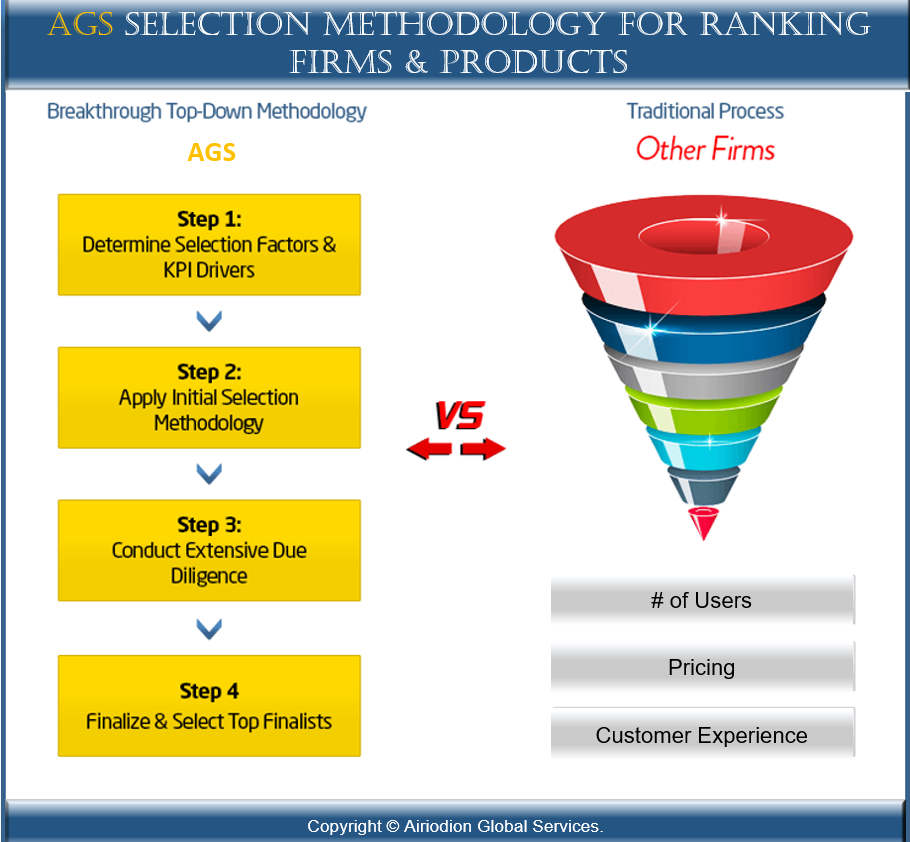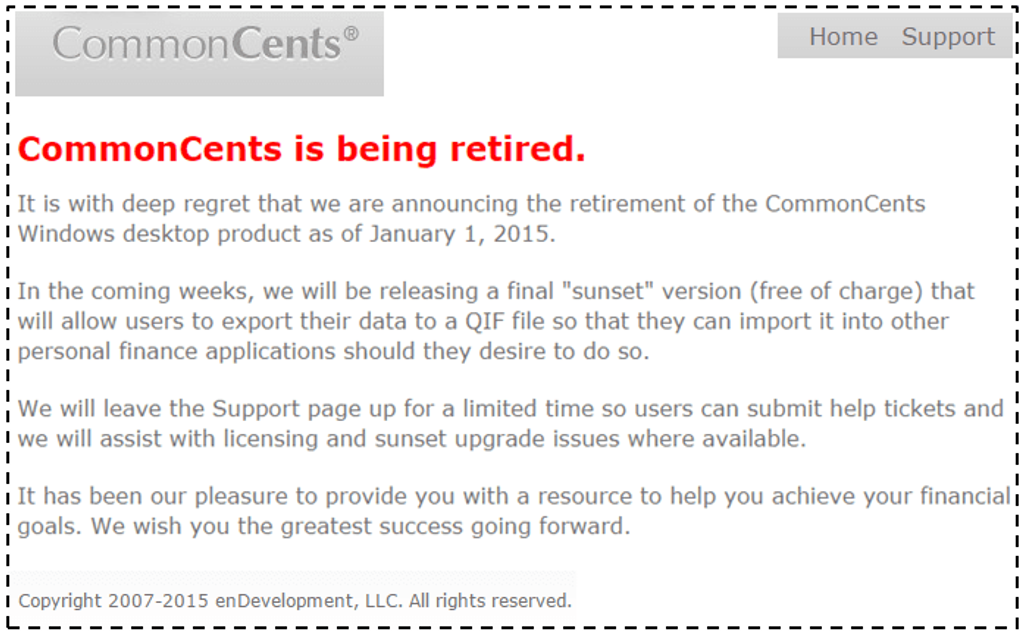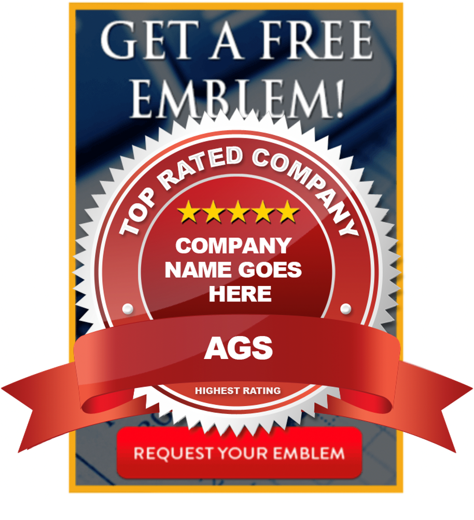AGS’ Methodologies for Ranking Firms & Products
Traditional methodologies used for ranking organizations, consulting firms, products, and professional service providers, are often focused on pricing, users, firm size, customer sentiments, features, and services.
To generate a more reflective ranking, AGS went beyond basic key performance ranking indicators. We developed the breakthrough “Top-Down Ranking Methodology” below that is based on the intrinsic consumer value provided by each ranked firm, and not how large or how much revenue the company is making.
What is Our Value Proposition?
Studies from Google, American Lifestyles Magazine, Deloitte, and other consumer trends show that the average consumer goes online to search and review firms before deciding on which organization to use.
Specifically, American Lifestyles, which tracks and publishes consumer trends reported that more than 69% of consumers seek out reviews and online rankings on firms, products, tools, and services before making a final decision on which organization to purchase from, do business with or work for.
Finding a top-notch organization, service, and product can be a daunting task for a consumer or potential employee, especially when that individual is not very familiar with the industry, sector, and segment.
Airiodion Global Services’ Editorial team is committed to simplifying the research that buyers, prospects, consumers, and potential employees conduct before choosing to buy from, work with, or work for an organization. This is our value proposition.
We also publish our rankings for free to the general public.
Our Millions of Viewers are the Main Focus
Over the last year, AGS has received over 4.3M consumer impressions, and our strategic focus is centered on providing the best value to these millions of readers.
100% of our research, reviews, and rankings are done from the viewpoint of end-users, not from the viewpoint of organizations.
We are fully dedicated to transparency, independence, comprehensiveness, and objectivity in our ranking and reviewing processes for our readers.

What is Our Objective Selection Approach?
Unlike other publications that often require a fee from the organizations, they are reviewing and ranking, AGS does not charge any organization for our reviews or rankings.
In fact, most consulting firms, organizations, and businesses do not even realize they are being reviewed, researched, and ranked until after our ranking has been finalized and published to the general public, and to our millions of viewers.
We do this to ensure objectivity and independence. After publishing our rankings, we then send a notification to the ranked firms alerting them about their rankings and reviews.
Has Your Firm Been Ranked by AGS?
If your organization has been ranked by AGS, click below for information on getting your free Award Emblem to promote your ranking with your users, customers, clients, and on social media.
Get Your Free AGS Award Emblem
Selection Methodology for Identifying and Finalizing Lists of Top Ranking Firms & Products
Click below to be taken directly to the methodology section that is of interest to you:
Don’t Miss:
- Promoting Your Award
- Corrections Requests
- Award Criteria Disclosure
- How Long Does a Firm Remain on Our Ranking?
- Do Firms Have a Say in Their Ranking?
- Can Firms Request to be Removed?

Contact AGS if you have any questions.
SELECTION METHODOLOGY FOR RANKING & REVIEWING FIRMS
Step 1: Generate a Comprehensive List
Using publicly available sources and databases, AGS’ Editorial team identifies a wide range of firms and services that are operating within a particular industry, sector, geographic location, or segment. Our Editorial staff then compiles a comprehensive list of the identified organizations and products.
Step 2: Apply Initial Threshold Filters
After AGS Editorial team members have developed the comprehensive and universal list of firms, we then apply an initial set of selection filters to narrow down the list.
Initial Filters:
- Customers’ Sentiment Assessment
- Resource Availability
- Unique and Customized Services
- Holistic Experience Level of Consulting Staff or Resources
- Organizational Transparency
- Value-Added Services
- Scale of Services
- Staying Relevant
- Quality of the Organization’s Website
(1) Customers’ Sentiment Assessment (Negative or Positive Reviews)
As part of our customers’ sentiment analysis, we conduct detailed online assessments of the reviews provided by consumers for each of the organizations being reviewed.
Negative Consumer Sentiment Assessments:
We fully understand that a consumer is more likely to take the time to provide a negative review of an organization than they are to take the time to go online to provide a positive review. As such, our sentiment assessment is based on the level of negative consumer sentiment for a particular firm relative to the firm’s peers (the other firms in the same sector that are being reviewed by our Editorial team).
Positive Consumer Sentiment Assessments:
In addition to reviewing and understanding the sources of negative sentiments for the firms being ranked, we also review and understand the sources of positive consumer feedback and sentiment for the firms being reviewed.
Our positive sentiment assessment for a particular firm is conducted in comparison against positive sentiments and customer reviews received by the other firms in the group been reviewed.
(2) Resource Availability
An organization or consulting firm’s greatest assets are the professional resources that work for that organization. A key dimension we review as part of our selection process is the estimated number of “available” professionals working for and supporting that organization.
An organization that has the right number of available professional or consulting staff (per total client base) will have the necessary bandwidth to provide the right level of consulting and professional support to its clients.
We leverage public information and platforms, including LinkedIn, Glassdoor, and others to determine an estimated number of resources that work for the companies on our review list. We also leverage each company’s website, public announcements, client mentions (e.g., when a client has mentioned a consulting firm or organization on an online platform or social media), and other metrics and databases to assess the number of clients that an organization is providing value to.
It is impossible to objectively identify the exact number of clients and consumers that an organization has. As such we apply an extrapolation probability process.
- Extrapolation: the action of taking a small sample dataset, and estimating a broader number (inferring unknown values from trends in the known data) by assuming that existing trends will continue or a current method will remain applicable.
(3) Customized Services
A customized service is a service that has been customized for a particular client or consumer. The level and scale of flexibility in providing customized professional service is another review and selecting criterion used in our assessment logic. We favor firms that provide a wide range of standardized, as well as customized services to consumers.
The more options a consumer or client has, the higher the value they gain from doing business with that organization.
(4) Holistic Experience Level of Firm’s Consulting Staff or Resources
In addition to the number of available professional or consulting resources per client/customer base, we also consider the combined experience level of the professional team that are often allocated to projects, including the combined years of experience, certifications, and leading roles within their respective field of expertise.
A consulting, professional services, or assigned project team with an extensive level of expertise and many years of experience will have the needed skills to manage a wide range of client issues and challenges.
(5) Organizational Transparency
AGS’ ranking framework is more favorable to organizations that have a transparent policy. Having a transparent policy means being transparent with employees, consumers, and other parties they do business with.
Organizational transparency can also include a policy that encourages clients / potential clients to ask questions and to get to know the organization’s team and staff.
(6) Value-Added Services
Value-add services refer to non-core services that can be added to a company’s core product or service to enhance the consumer experience.
Offering the lowest prices may not always be the best option for consumers in the long run.
As part of our AGS selection and ranking factors, we give priority to consulting firms, professional services organizations, and companies that do a lot more than just offering the cheapest services or products.
Our selection criteria favors professional services firms that have a well-defined policy of providing value-added services that enhances the consumer and end-user experience.
An example of a consulting firm that has a value-add mentality is a firm that works alongside its clients as an integral part of each client’s business team, rather than just being a “numbers cruncher” (doing the bare minimum that is stated on the Statement of Work or contract) in order to earn a hefty fee.
(7) Scale of Services
When ranking consulting firms, our selection and review methodology favors consulting firms that provide a full range of services. However, we also make include and make allowances for boutique firms that are just focused on specific niches and services.
(8) Staying Relevant
The relationship a business has with a consultant, professional services, or vendor normally ends up being a long-term relationship. As such, it is essential for us to provide value to our millions of readers by ranking firms that are constantly improving their services and business practices and staying up-to-date on industry requirements and regulatory standards.
(9) Quality of Reviewed Firms’ Website
Consumers, potential employees, and even vendors like to review an organization’s website for information before contacting or engaging with that organization.
A website with a slow or poor UI/UX (User Interface/User Experience), as well as sites that don’t do a good job in providing the relevant and adequate amount of essential information is, sometimes, a telling sign of the low-level type of service that a consumer might end up receiving if they do business with that organization.
As such, as part of our ranking selection, our teams considered the ease-of-use, UI/UX, and level of informational details on a firm’s website as part of our review process.
Step 3: Deep Dive Assessment
After trimming down our initial comprehensive list using our initial methodology filters, we then conduct a deep dive assessment of the remaining firms on our list to select our final list of top rated companies for consumers and employees.

Step 4: Generating the Final List of Top Firms
Based on the results of our end-to-end organizational assessment, we then finalize the organizations and entities that make it into our list of top ranked organizations.
As referenced in the sections above, most firms do not even realize they are being researched and reviewed until we have published our rankings. This is to ensure an absolute level of independence and objectivity in our ranking and reviews.
Scale of AGS Selection Factors
There are possibly hundreds of ranking selection criteria that can be applied to any ranking methodology. It is nearly impossible for any ranking publisher, including AGS, to accommodate all possible ranking filters when developing a ranking model.
Depending on the ranking, industry, sector, and timing, our ranking methodology will include a few or more of the following selection factors:
- Consumer Sentiment
- Transparency
- Organizational Performance
- Employee Reviews
- Negative or Positive News Stories about the Firm
- Extensiveness of Provided Services
- Received Rewards & Accolades
- Ease-of-use
- Features & Benefits
- Level of Customized Service & Value-Add
- History of Innovation & Growth
- Fees | Cost
- Overall Quality of Services Provided to Clients/Consumers
- Holistic Level of Experience and Years of Expertise
- Team Excellence
- Service/Product Options Available to Consumers
- …and many more
Focus
Our focus is on the everyday consumer and on our millions of viewers who are seeking information on best-ranked companies. Our research activities are conducted from the consumer’s (and NOT from the organization’s) perspective.
We give consumers (individuals and business owners) exactly the information they need without any hype or jargon. AGS’ Editorial team members spend countless hours and days reviewing each and every organization that we review. We then publish our reviews and rankings for anyone to view for free.
AGS’ METHODOLOGY FOR PRODUCTS
Methodology for Selecting Top Ranked Products and Tools
What is the process used by AGS for researching, reviewing, and ranking products/tools?
Using publicly available sources, databases, and platforms, we start out by identifying a comprehensive list of tools, software, and products that are available in a particular sector or market.
After generating the comprehensive list, AGS then applies selection factors to fine-tune and narrow down the list to the finalists that end up on our top ranked publications.
Examples of our product selection factors include:
- Ease-of-use of the product
- Consumer sentiment (negative or positive)
- User interface
- User experience
- Online reviews from customers
- Scale and robustness of the available features
- Security level
- Comprehensiveness – does it allow consumers to do what they need to do, or do consumers need to buy more added features to get the needed value?
- Cost-value relative to comparable products
- Maintenance requirements
- See more here: Selection Methodology for Top Ranked Companies
Longevity Selection Factor for AGS Ranked Products
Longevity is an estimated variable on how long a product will be around. Longevity is a key part of our product review and ranking process.
CommonCents is a great example of a tool that had short longevity. It was a tool that ignited the financial software transformation, but in 2015, due to extensive competition, lack of innovation, and loss of customers, it was eventually shut-down.

The point of the case study above is that when ranking any product, estimating longevity is a key factor. To estimate longevity, we assess various factors including the product’s popularity, growth, firm’s history of innovation, and revenue potential
AGS’ Objectivity
As referenced above, AGS’s top ranking products and tools publications are always 100% independently researched and published.
Contact us if you have any feedback on a product or company that has been included in our top ranked publications.
Note: Content on OCM Solution's ocmsolution.com website is protected by copyright. Should you have any questions or comments regarding this OCM Solutions page, please reach out to Ogbe Airiodion (Change Management Lead) or the OCM Solutions Team today. OCM Solution was previously known as Airiodion Global Services (AGS).



